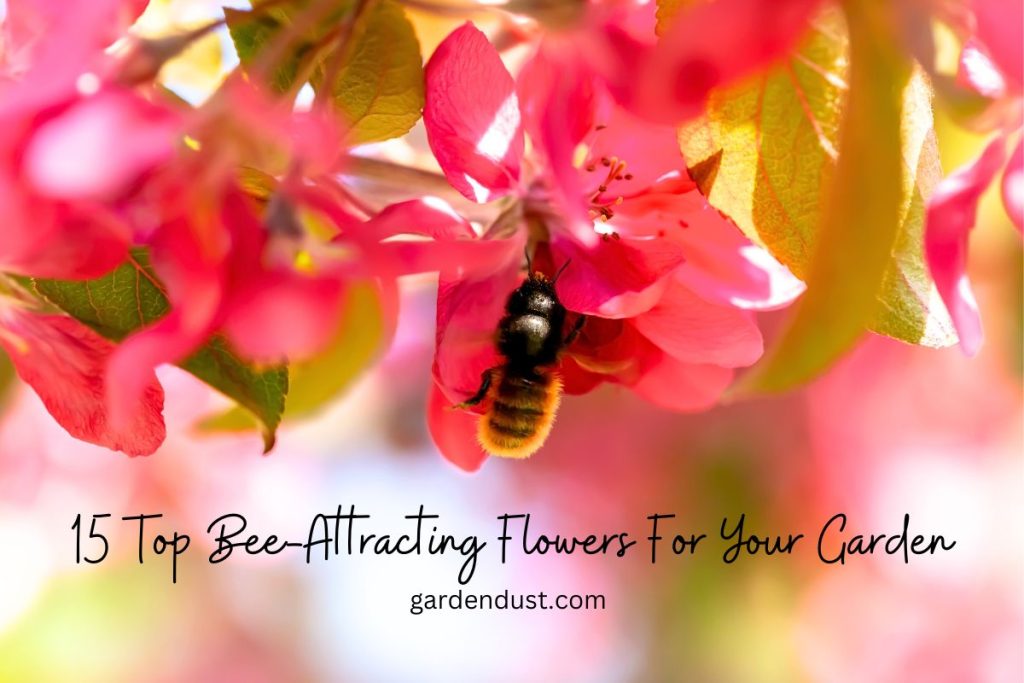Creating a bee-friendly garden is not only aesthetically pleasing but also essential for supporting pollinators like bees. By selecting the right flowers, you can turn your garden into a haven for these industrious insects. In this article, we’ll explore 15 top Bee-Attracting Flowers for Your Garden, providing both beauty and sustenance to your outdoor space. Let’s begin…
1-Lavender (Lavandula spp.):

Known for its fragrant, spiky blooms, lavender is a bee magnet. Bees are particularly drawn to the nectar-rich flowers, making it a delightful addition to your garden.
2-Bee Balm (Monarda spp.):

As the name suggests, bee balm is a favorite among bees. Its tubular flowers come in various colors, and its sweet nectar is irresistible to both honeybees and native bee species.
3-Sunflowers (Helianthus spp.):

Sunflowers are not only a symbol of summer but also a beacon for bees. The large, vibrant blooms provide ample pollen and nectar, attracting bees from afar.
4-Coneflowers (Echinacea spp.):

Coneflowers, with their daisy-like petals and raised centers, are not only visually appealing but also a rich source of nectar for bees, butterflies, and other pollinators.
5-Salvia (Salvia spp.):

With its long spikes of tubular flowers, salvia is a favorite among many bee species. It comes in a variety of colors and is known for its extended blooming period.
READ ALSO-20 Best Plants to Attract Hummingbirds
6-Foxglove (Digitalis purpurea):

Foxglove’s tubular flowers are perfect for bees, allowing them easy access to the nectar within. Be cautious with this plant, as it can be toxic if ingested.
7-Borage (Borago officinalis):

Borage, also known as the “bee plant,” produces clusters of small, star-shaped blue flowers that bees find irresistible. Both honeybees and native bees are attracted to its abundant nectar.
8-Catmint (Nepeta spp.):

Catmint, a member of the mint family, boasts aromatic leaves and spikes of lavender-blue flowers. Bees are drawn to the sweet fragrance and nectar-rich blooms.
9-Zinnias (Zinnia spp.):

Zinnias are easy-to-grow annuals with vibrant, daisy-like flowers. Their wide, flat landing pads make them a popular choice for bees seeking nectar.
10-Asters (Aster spp.):

Asters, with their daisy-like flowers, are a late-season favorite for bees. These hardy perennials provide a crucial food source for bees preparing for winter.
11-Black-Eyed Susans (Rudbeckia spp.):

Black-eyed Susans feature bright yellow petals with a dark central cone, creating a striking contrast that attracts bees and other pollinators.
12-Helenium (Helenium spp.):

Commonly known as sneezeweed, Helenium produces daisy-like flowers in various warm hues, providing bees with a late-season feast.
13-Butterfly Bush (Buddleja spp.):

While primarily attracting butterflies, the butterfly bush also draws bees with its long panicles of fragrant flowers. It’s a great addition for a wildlife-friendly garden.
14-Phlox (Phlox spp.):

Phlox varieties, whether creeping or tall, offer clusters of fragrant, tubular flowers that bees find irresistible. They add a burst of color and fragrance to your garden.
15-Goldenrod (Solidago spp.):

Often wrongly accused of causing hay fever (it’s actually ragweed), goldenrod is a late-season bloomer that provides a vital food source for bees before winter sets in.
Transforming your garden into a haven for bees is not only a visually rewarding experience but also a meaningful contribution to the well-being of these essential pollinators. By incorporating these 15 bee-attracting flowers, you’ll not only enhance the beauty of your outdoor space but also play a crucial role in supporting biodiversity and the health of our ecosystems. Happy Gardening…..







